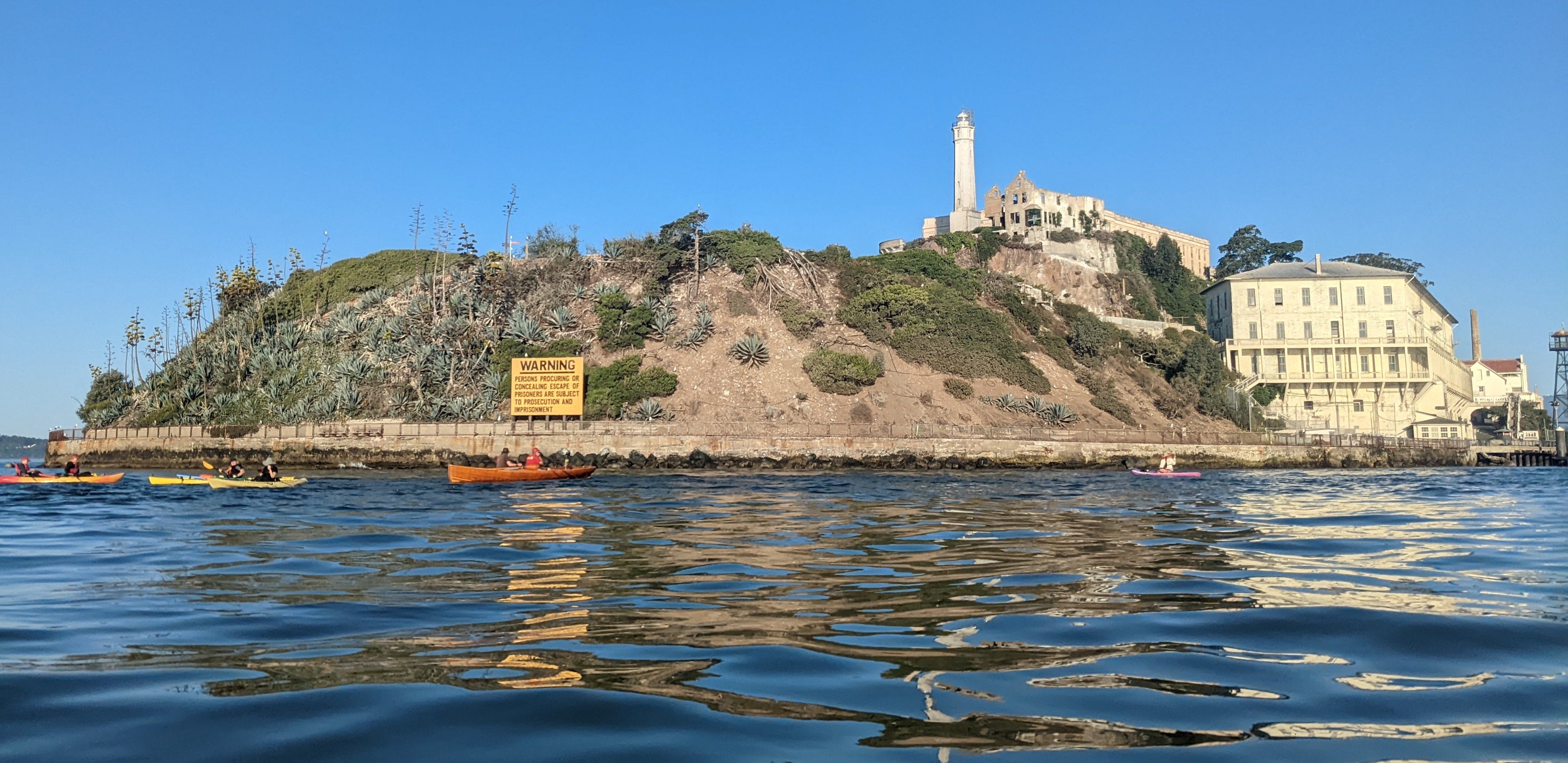You can also listen to this post on the Reset Button podcast.
When I first started to swim in the ocean, it was in a shallow, protected cove halfway up the southern reach of San Francisco Bay. Coyote Point is a good twenty-five miles from the open ocean, well inland of the Golden Gate, facing east toward the tame weather and waters of the Bay’s midsection, exposed to nothing more dangerous on most days than some afternoon wind and the occasional small fishing boat.
Thanks for reading Postcards from the Waterline! Subscribe for free to receive new posts and support my work.
Still, when I first contemplated getting into that water, it seemed as wild and daunting as the English Channel. A light breeze ruffled the limestone-gray surface of the water into little wavelets. But the closer I got to the water the bigger those waves looked: Like chop, or rough water, really. I looked closer and noticed little whitecaps forming on some of them. Waves were even breaking on the beach. Tiny surf, but still surf! I wasn’t seriously considering going out in these conditions with no boat to protect me, no surfboard to cling to, no floaty to hold me up, was I?
And who knows what horrors lay under that forbidding surface. The Bay is filled with creatures that are bigger, stronger, faster, and hungrier than I. Seals, sea lions, and sharks are all known to be common in these waters. There have been jellyfish in this cove. Some jellyfish stings can be deadly!
Never mind that the Coyote Point cove is about two to six feet deep at low tide and no more than ten or fifteen feet deep at the highest tide, that the jellyfish here don’t have lethal stingers, that the seals and sharks that swim here don’t bite, and the sea lions don’t wander this far south.
I didn’t know all this the first time I ventured into the water here. For me, I was swimming in (and over) all the mysteries of the deep. And I was doing it alone.

Mind you, this is not the recommended way to do open-water swimming. It really is best to take a buddy with you, especially in unknown waters, to help you make better decisions, to give you physical and emotional support if you need it, and, in the worst case, to call 911 and tell the rescuers where to look for your body.
But for me, at the time, I was too shy to swim with anyone else. I needed to face my fear alone. Trying to muster my courage while dealing with the complexities of interpersonal dynamics would have been too much.
Plus, I was out of shape and a poor swimmer, so I was embarrassed to make my transition from tame to wild water in front of anyone.
So there I stood, early one summer morning, on what seemed the edge of civilization, the parking lot behind me, the raging sea before me, and the pitiless sky above me.
My swim that day was less than fifteen minutes in duration and just a few hundred yards in total distance. The water was probably 65º Fahrenheit (18º Celsius), a temperature that now, ten years later, I would consider balmy and tropical, but which at the time seemed bitterly cold, so of course I armored myself against the elements by pulling on a 3/4 wetsuit. And, since my land-borne trepidation had blossomed into full-on fear once I was actually immersed in this menacing body of water, my entire swim was conducted within a dozen yards of the shore, and along a narrow, comforting band defined by where I could still see my car.
In other words, I was doing laps, just like at the pool: fifty yards down, fifty yards back.
After a handful of these “lengths” the combination of my fear-stoked racing heart and my pitifully inefficient windmill-style swim stroke had worn me out. I retreated to the shore, with a few nervous backward glances to make sure nothing to seaward was sneaking up on me, and got out of the water.
I had just become an open-water swimmer.
***
The very first human swimmers were, of course, open-water swimmers. When our ancestors descended from the trees onto the mixed scrublands and open savannah of ancient Africa, there were no doubt a few who, when coming across a body of water, decided it would be better (and more fun!) to try and swim across it rather than take the long, dusty, walking route around it. Assuming they weren’t eaten by crocodiles or hippos, these aquatic pioneers survived to pass their genes along to us. So humans have probably been swimming in lakes, ponds, streams, rivers, and even the ocean since there were humans.
With civilization came the possibility of taming water, even bringing it indoors in large enough quantities for bathing or swimming. The Romans had their baths, elaborate constructions of stone, lead plumbing, and heating, to allow for indoor bathing in both cold and hot water.
It wasn’t until much later, however, that humanity began actively swimming in artificial pools of water, first outdoors and then eventually in massive indoor settings.

Once we did, though, the sport of swimming really took off. The early twentieth century saw enormous growth of public pool construction, first in America, England, Australia, and New Zealand, then expanding rapidly around the world in the second half of the century. Pools made swimming and swimming instruction available to far more people than ever before.
At the same time, advances in pool chemistry helped ensure that those pools did not become vectors of disease transmission. Chlorination helped keep us safe, destroying microbes that humans (and children especially) tend to bring into the water, either on or in their bodies.
Unlike a pond or the ocean, a pool does not have its own native ecology. It is not a dynamic system of interlocking micro- and macro-organisms, with the ability to absorb foreign organisms and adapt to or eliminate them. A pool is just a large box filled with water. Additionally, pools are self-contained, and much smaller than the average pond or lake, so they can easily be taken over by virulent microorganisms.
The response, at least in America, has been to bomb the microbes out of existence with ever-increasing doses of chlorine and chloramine.
There are clear benefits: You can swim, or send your kids to their swimming lessons, without fear of contracting anything worse than an ear infection or a case of athlete’s foot. But the side effect is that the water we swim in becomes truly dead: Not only lifeless but lethal. Slip a goldfish into the YMCA pool, and it will die. The air above the water’s surface, especially in an indoor pool, becomes fumigated with chlorine gas.
Pool swimming, for those of us who do it a lot, becomes less of a communion with a fundamental element and more of an exercise in physical fitness and hygiene. You might grow to like that “eau de chlorine” scent that others find increasingly characteristic of you, and which marks you as a pool swimmer, but it’s not great for your skin, drying it out. It’s not good for your hair, which becomes more and more brittle and straw-like as the months go on, and may even, if you’re blond, acquire a greenish tinge. That is, unless you apply additional chemicals, in the form of swimmers’ shampoo, which is designed to wash out that chlorine or counteract its chemical effects.
And god forbid you should try to swim in a pool without wearing goggles: You will emerge, eyeballs stinging and as red as a baboon’s, your vision blurred and your sinuses crying out for relief.
As a result, many of us—a minority of swimmers, but still large in absolute numbers—have become tired of indoor swimming. We are tired of swimming back and forth, back and forth, over the same black lane lines, in the same blue bleached water, adding up yards or meters but never really going anywhere, never seeing anything new. We long to swim “out of the box.”
And so we come to open-water swimming, wild swimming, free swimming. We stand, like our ancestors, on the edge of some enticing, or terrifying, or enticingly terrifying body of water, we look out at some point in the distance, and we think to ourselves, “I wonder if I could swim there?”

Thanks for reading Postcards from the Waterline! Subscribe for free to receive new posts and support my work.



